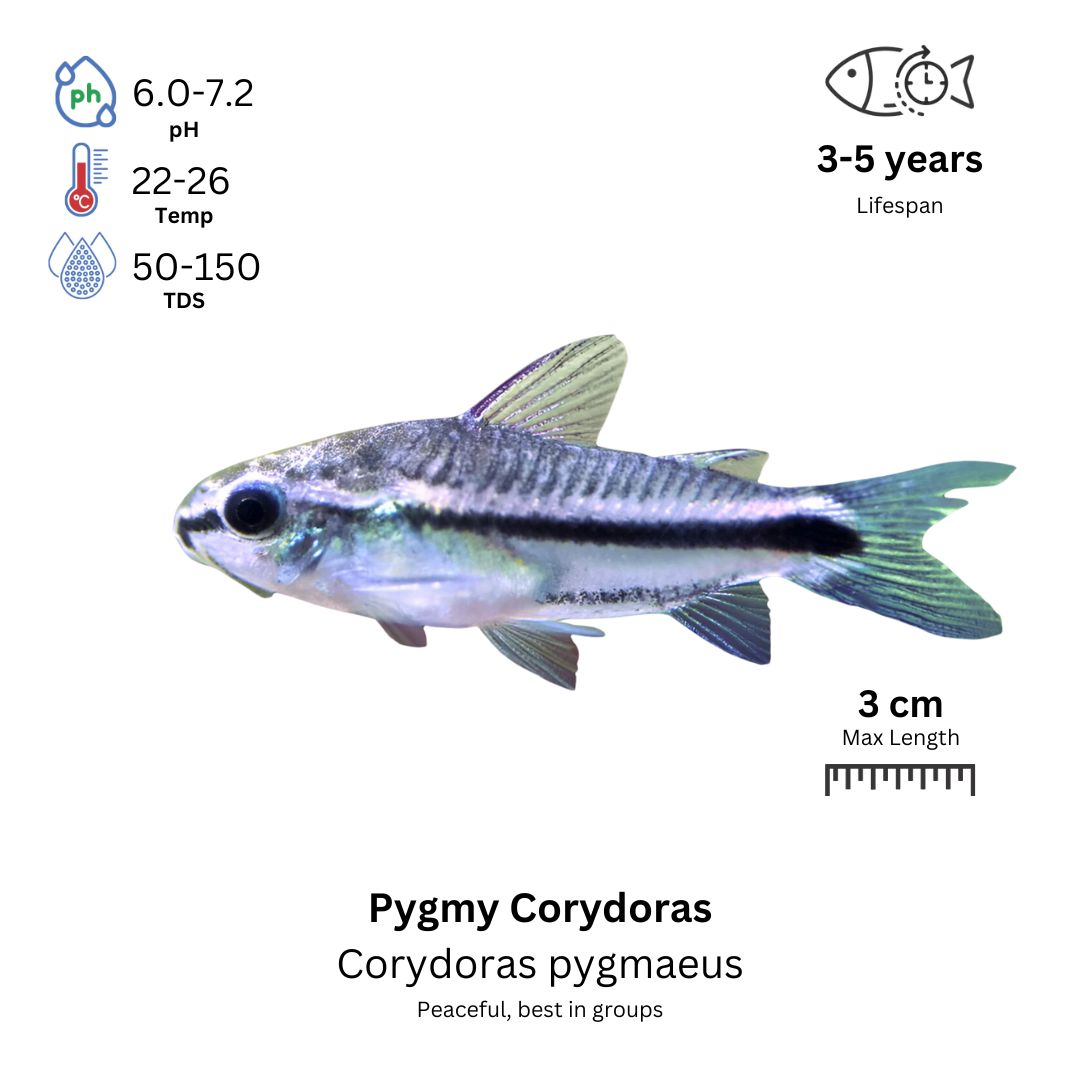Pygmy Corydoras: Species Profile
Species Overview
Common Name: Pygmy Corydoras
Scientific Name: Corydoras pygmaeus
Adult Size: Up to 1 inch (2.5 cm)
Life Expectancy: 3-5 years
Characteristics
- Family: Callichthyidae
- Origin: South America (Amazon Basin)
- Social: Highly social; thrives in schools
- Tank Level: Bottom to mid-level swimmers
- Minimum Tank Size: 10 gallons
- Diet: Omnivorous
- Breeding: Relatively easy in a well-maintained tank
- Care Level: Beginner-friendly
- Preferred pH: 6.0–7.5
- Water Hardness: Soft to moderately hard
- Temperature: 72–79°F (22–26°C)
Origin and Distribution
Pygmy Corydoras are native to the tributaries of the Amazon River in South America. They are commonly found in slow-moving rivers and floodplain lakes, where they inhabit sandy substrates and areas rich in vegetation.
Colors and Markings
Pygmy Corydoras are small, silver fish with a distinctive black horizontal stripe running along the length of their bodies. Their subtle coloration allows them to blend well in natural environments, but their tiny size and schooling behavior make them stand out in aquariums.
Tankmates
Pygmy Corydoras are peaceful and do well in community tanks with similarly gentle species. Suitable tankmates include:
- Small tetras, rasboras, or guppies
- Dwarf shrimp species
- Other small corydoras or bottom-dwelling fish
Avoid housing them with aggressive or large fish, as their small size makes them vulnerable.
Habitat and Care
To replicate their natural habitat, set up a tank with plenty of plants and soft substrate. Key care guidelines include:
- Tank Setup: Use fine sand or smooth gravel to protect their sensitive barbels. Include driftwood, live plants, and floating vegetation for cover and foraging.
- Water Quality: Maintain clean, well-oxygenated water with stable parameters. A gentle current mimics their natural environment.
- Maintenance: Perform regular water changes to keep nitrate levels low.
Diet and Feeding
Pygmy Corydoras are omnivores and thrive on a varied diet. Their food preferences include:
- High-quality sinking micro-pellets or wafers
- Live or frozen foods such as daphnia, brine shrimp, or micro-worms
- Occasional algae wafers or blanched vegetables
Feed small amounts 1-2 times a day to ensure food reaches the tank’s bottom where they can access it.
Gender Differences
Mature females are slightly larger and rounder than males, particularly when viewed from above. Males are slimmer and more streamlined.
Breeding
Breeding Pygmy Corydoras is relatively straightforward with the right setup:
- Breeding Tank: Use a separate tank with soft substrate and dense planting.
- Conditioning: Feed adults high-protein foods like live or frozen bloodworms to encourage spawning.
- Spawning: Females lay eggs on leaves, glass, or other surfaces, and males fertilize them.
- Care for Eggs: Remove adults after spawning to protect the eggs. Fry hatch in 3-5 days and can be fed infusoria or finely crushed flakes.
Further Research
Pygmy Corydoras are delightful additions to nano or community tanks. Their active behavior and schooling nature make them a favorite among aquarists, and learning more about their care ensures they thrive in captivity.
FAQ
Q: Do Pygmy Corydoras need to be in a school?
A: Yes, they are highly social and should be kept in groups of at least 6 to feel secure and exhibit natural behaviors.
Q: Are they suitable for a planted tank?
A: Yes, they thrive in planted tanks and benefit from the cover and foraging opportunities plants provide.
Q: How active are Pygmy Corydoras?
A: Unlike many corydoras, Pygmy Corydoras often swim in the mid-water column as well as the bottom, making them more visible and active in the tank.


Reviews
There are no reviews yet.